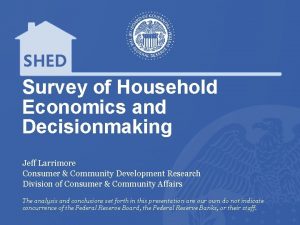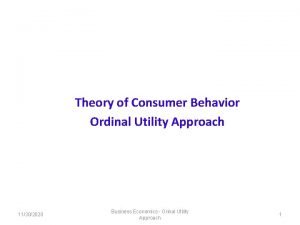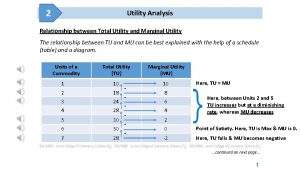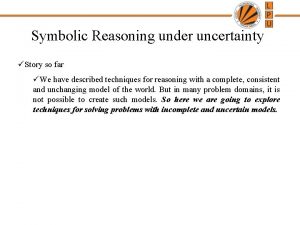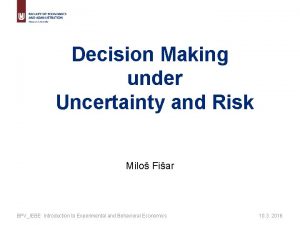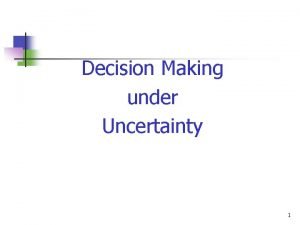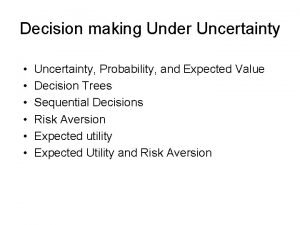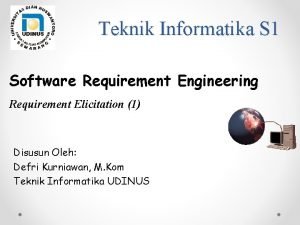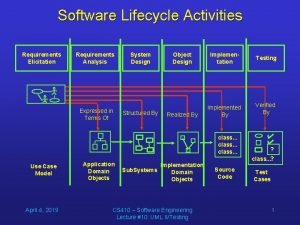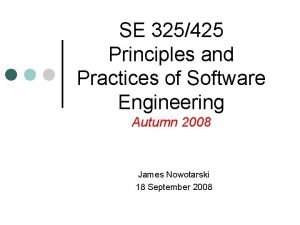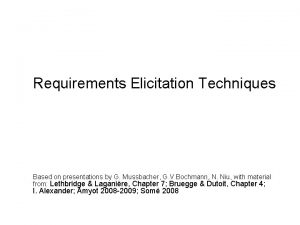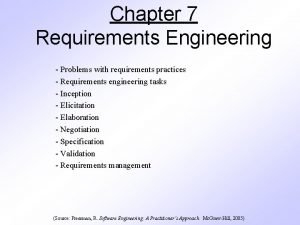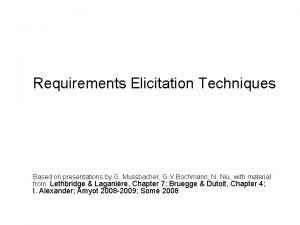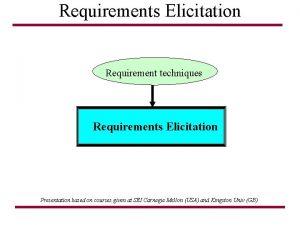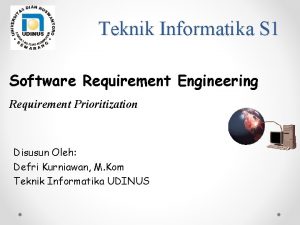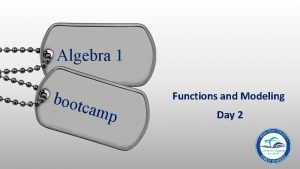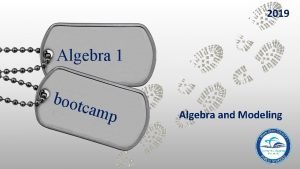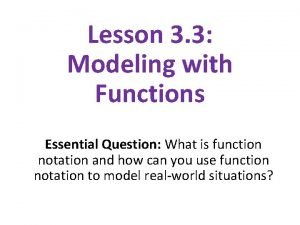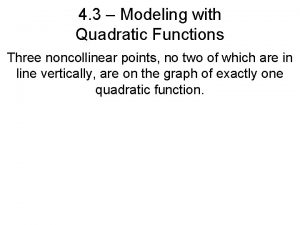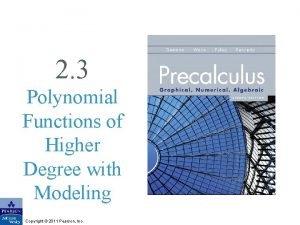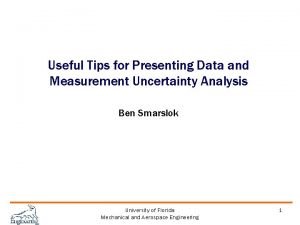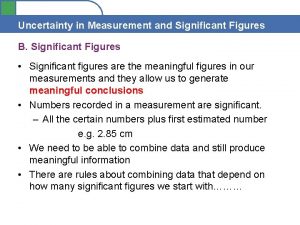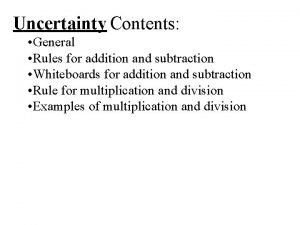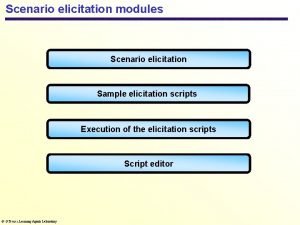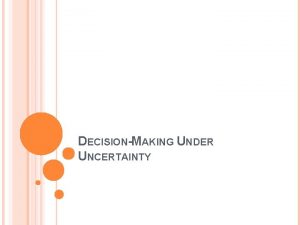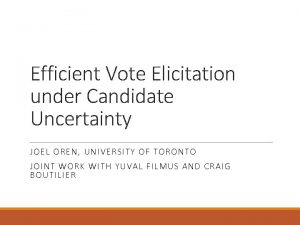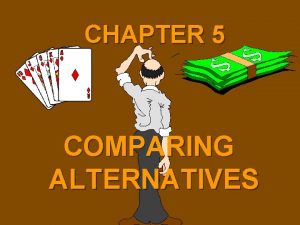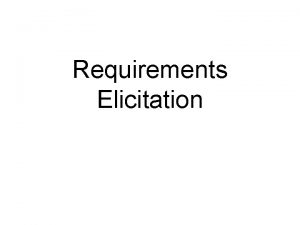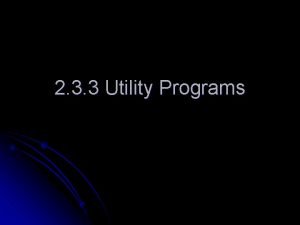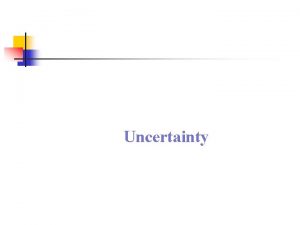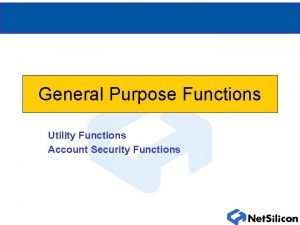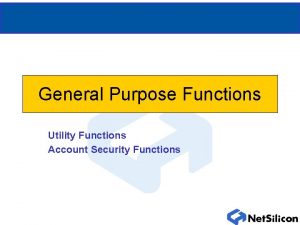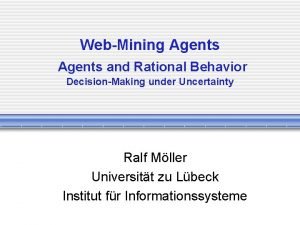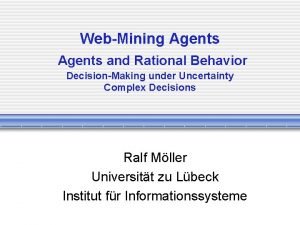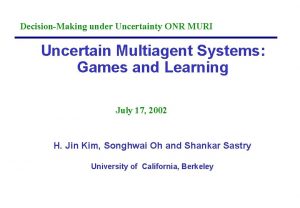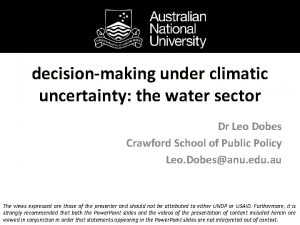Decisionmaking under uncertainty modeling alternatives utility functions elicitation



![Expected value [1] Eisenführ, Weber & Langer (2009) 18. 10. 2019 4 MS-E 2191 Expected value [1] Eisenführ, Weber & Langer (2009) 18. 10. 2019 4 MS-E 2191](https://slidetodoc.com/presentation_image_h2/7bb30e97da807b9836b08697e05610f6/image-4.jpg)




![Conditions If the DM’s preferences satisfy the axioms (detailed in p. 240 -245 [1]) Conditions If the DM’s preferences satisfy the axioms (detailed in p. 240 -245 [1])](https://slidetodoc.com/presentation_image_h2/7bb30e97da807b9836b08697e05610f6/image-9.jpg)

![Certainty equivalent (2) [1] Eisenführ, Weber & Langer (2009) 18. 10. 2019 11 MS-E Certainty equivalent (2) [1] Eisenführ, Weber & Langer (2009) 18. 10. 2019 11 MS-E](https://slidetodoc.com/presentation_image_h2/7bb30e97da807b9836b08697e05610f6/image-11.jpg)
![Basic-reference-lottery ∼ [1] Eisenführ, Weber & Langer (2009) 18. 10. 2019 12 MS-E 2191 Basic-reference-lottery ∼ [1] Eisenführ, Weber & Langer (2009) 18. 10. 2019 12 MS-E 2191](https://slidetodoc.com/presentation_image_h2/7bb30e97da807b9836b08697e05610f6/image-12.jpg)
![Example process[3] From equations (1) and (2) [3] MS-E 2134, lecture 3. 18. 10. Example process[3] From equations (1) and (2) [3] MS-E 2134, lecture 3. 18. 10.](https://slidetodoc.com/presentation_image_h2/7bb30e97da807b9836b08697e05610f6/image-13.jpg)


![Risk premium An exact measure for the risk attitude is the risk premium[1] which Risk premium An exact measure for the risk attitude is the risk premium[1] which](https://slidetodoc.com/presentation_image_h2/7bb30e97da807b9836b08697e05610f6/image-16.jpg)




![Incomplete information concerning the probabilities Preference ⇔ ⇔ neither true ⇔ [1] Eisenführ, Weber Incomplete information concerning the probabilities Preference ⇔ ⇔ neither true ⇔ [1] Eisenführ, Weber](https://slidetodoc.com/presentation_image_h2/7bb30e97da807b9836b08697e05610f6/image-21.jpg)



![Stochastic dominance Other approach[1]: - Assuming the DM prefers more to less and we Stochastic dominance Other approach[1]: - Assuming the DM prefers more to less and we](https://slidetodoc.com/presentation_image_h2/7bb30e97da807b9836b08697e05610f6/image-25.jpg)





![Sources [1] Eisenführ, Franz, Martin Weber, and Thomas Langer. Rational decision making. Springer, 2009. Sources [1] Eisenführ, Franz, Martin Weber, and Thomas Langer. Rational decision making. Springer, 2009.](https://slidetodoc.com/presentation_image_h2/7bb30e97da807b9836b08697e05610f6/image-31.jpg)



- Slides: 34

Decision-making under uncertainty: modeling alternatives, utility functions, elicitation, incomplete information Aaro Valtonen Presentation 10 18. 10. 2019 MS-E 2191 Graduate Seminar on Operations Research Fall 2019 The document can be stored and made available to the public on the open internet pages of Aalto University. All other rights are reserved.

Themes -How to model risky alternatives, take the preferences of the DM into account and find the optimal alternative? -What if there is incomplete information? 18. 10. 2019 2 MS-E 2191 Graduate Seminar on Operations Research: “Introduction to Portfolio Decision Analysis and Efficiency Analysis”

1. Evaluation of risky alternatives 18. 10. 2019 3 MS-E 2191 Graduate Seminar on Operations Research: “Introduction to Portfolio Decision Analysis and Efficiency Analysis”
![Expected value 1 Eisenführ Weber Langer 2009 18 10 2019 4 MSE 2191 Expected value [1] Eisenführ, Weber & Langer (2009) 18. 10. 2019 4 MS-E 2191](https://slidetodoc.com/presentation_image_h2/7bb30e97da807b9836b08697e05610f6/image-4.jpg)
Expected value [1] Eisenführ, Weber & Langer (2009) 18. 10. 2019 4 MS-E 2191 Graduate Seminar on Operations Research: “Introduction to Portfolio Decision Analysis and Efficiency Analysis”

Expected value For example, given two commuting routes with different commuting times: A (rational) risk-neutral DM chooses route 1. -> It minimises the commuting time (in the long run). However, a risk-seeking DM might choose route 2. -> For example when late to work. 18. 10. 2019 5 MS-E 2191 Graduate Seminar on Operations Research: “Introduction to Portfolio Decision Analysis and Efficiency Analysis”

Utility • By mapping the values of different events to utilities, we can model different attitudes towards the values and the behaviour under risk. • Usually for the worst event the utility is assigned to zero and the value of one is given for the best event. • The utility allows to make rational decisions under risk, even though the exact meaning of the term “utility” may be uncertain. [1] Eisenführ, Weber & Langer (2009) 18. 10. 2019 6 MS-E 2191 Graduate Seminar on Operations Research: “Introduction to Portfolio Decision Analysis and Efficiency Analysis”

Utility function 18. 10. 2019 7 MS-E 2191 Graduate Seminar on Operations Research: “Introduction to Portfolio Decision Analysis and Efficiency Analysis”

Expected utility (1) 18. 10. 2019 8 MS-E 2191 Graduate Seminar on Operations Research: “Introduction to Portfolio Decision Analysis and Efficiency Analysis”
![Conditions If the DMs preferences satisfy the axioms detailed in p 240 245 1 Conditions If the DM’s preferences satisfy the axioms (detailed in p. 240 -245 [1])](https://slidetodoc.com/presentation_image_h2/7bb30e97da807b9836b08697e05610f6/image-9.jpg)
Conditions If the DM’s preferences satisfy the axioms (detailed in p. 240 -245 [1]) of (i) complete ordering, (ii) continuity and (iii) independence, the elicited utility function has the properties mentioned earlier and the expected utility can be used to find the best alternative[1]. [1] Eisenführ, Weber & Langer (2009) 18. 10. 2019 9 MS-E 2191 Graduate Seminar on Operations Research: “Introduction to Portfolio Decision Analysis and Efficiency Analysis”

2. Determining the utility function 18. 10. 2019 10 MS-E 2191 Graduate Seminar on Operations Research: “Introduction to Portfolio Decision Analysis and Efficiency Analysis”
![Certainty equivalent 2 1 Eisenführ Weber Langer 2009 18 10 2019 11 MSE Certainty equivalent (2) [1] Eisenführ, Weber & Langer (2009) 18. 10. 2019 11 MS-E](https://slidetodoc.com/presentation_image_h2/7bb30e97da807b9836b08697e05610f6/image-11.jpg)
Certainty equivalent (2) [1] Eisenführ, Weber & Langer (2009) 18. 10. 2019 11 MS-E 2191 Graduate Seminar on Operations Research: “Introduction to Portfolio Decision Analysis and Efficiency Analysis”
![Basicreferencelottery 1 Eisenführ Weber Langer 2009 18 10 2019 12 MSE 2191 Basic-reference-lottery ∼ [1] Eisenführ, Weber & Langer (2009) 18. 10. 2019 12 MS-E 2191](https://slidetodoc.com/presentation_image_h2/7bb30e97da807b9836b08697e05610f6/image-12.jpg)
Basic-reference-lottery ∼ [1] Eisenführ, Weber & Langer (2009) 18. 10. 2019 12 MS-E 2191 Graduate Seminar on Operations Research: “Introduction to Portfolio Decision Analysis and Efficiency Analysis”
![Example process3 From equations 1 and 2 3 MSE 2134 lecture 3 18 10 Example process[3] From equations (1) and (2) [3] MS-E 2134, lecture 3. 18. 10.](https://slidetodoc.com/presentation_image_h2/7bb30e97da807b9836b08697e05610f6/image-13.jpg)
Example process[3] From equations (1) and (2) [3] MS-E 2134, lecture 3. 18. 10. 2019 13 MS-E 2191 Graduate Seminar on Operations Research: “Introduction to Portfolio Decision Analysis and Efficiency Analysis”

3. Risk attitude 18. 10. 2019 14 MS-E 2191 Graduate Seminar on Operations Research: “Introduction to Portfolio Decision Analysis and Efficiency Analysis”

Risk attitude A decision maker is either (i) risk neutral, (ii) risk averse or (iii) risk seeking when faced with risky options. Risk attitude The DM’s attitude towards risk can be determined from the shape of the DM’s utility curve. Utility function Risk neutral Risk averse Risk seeking 18. 10. 2019 15 MS-E 2191 Graduate Seminar on Operations Research: “Introduction to Portfolio Decision Analysis and Efficiency Analysis”
![Risk premium An exact measure for the risk attitude is the risk premium1 which Risk premium An exact measure for the risk attitude is the risk premium[1] which](https://slidetodoc.com/presentation_image_h2/7bb30e97da807b9836b08697e05610f6/image-16.jpg)
Risk premium An exact measure for the risk attitude is the risk premium[1] which is zero for a risk-neutral, positive for a risk-averse and negative for a riskprone risk attitude. - Risk averse attitude: RP(a) = 100€ - 80€ = 20€ “The DM willing to avoid risk and lose an expected amount of 20€ for a safe sum of 80€. - Risk seeking attitude: RP(a) = 100€ - 110€ = -10€ “The DM willing to reject an expected amount of up to 10€ for the opportunity to take part in the lottery. “ [1] Eisenführ, Weber & Langer (2009) 18. 10. 2019 16 MS-E 2191 Graduate Seminar on Operations Research: “Introduction to Portfolio Decision Analysis and Efficiency Analysis”

Graphical interpretation Risk averse attitude: Risk seeking attitude: 18. 10. 2019 17 MS-E 2191 Graduate Seminar on Operations Research: “Introduction to Portfolio Decision Analysis and Efficiency Analysis”

4. Incomplete information 18. 10. 2019 18 MS-E 2191 Graduate Seminar on Operations Research: “Introduction to Portfolio Decision Analysis and Efficiency Analysis”

Incomplete information 18. 10. 2019 19 MS-E 2191 Graduate Seminar on Operations Research: “Introduction to Portfolio Decision Analysis and Efficiency Analysis”

Incomplete information concerning the probabilities 18. 10. 2019 20 MS-E 2191 Graduate Seminar on Operations Research: “Introduction to Portfolio Decision Analysis and Efficiency Analysis”
![Incomplete information concerning the probabilities Preference neither true 1 Eisenführ Weber Incomplete information concerning the probabilities Preference ⇔ ⇔ neither true ⇔ [1] Eisenführ, Weber](https://slidetodoc.com/presentation_image_h2/7bb30e97da807b9836b08697e05610f6/image-21.jpg)
Incomplete information concerning the probabilities Preference ⇔ ⇔ neither true ⇔ [1] Eisenführ, Weber & Langer (2009) 18. 10. 2019 21 MS-E 2191 Graduate Seminar on Operations Research: “Introduction to Portfolio Decision Analysis and Efficiency Analysis”

Incomplete information concerning the probabilities Consequently the preference between two alternatives can be determined by solving the following LP-problems[1] Solutions of the problems: max. and min. Preference + Opposite signs [1] Eisenführ, Weber & Langer (2009) 18. 10. 2019 22 MS-E 2191 Graduate Seminar on Operations Research: “Introduction to Portfolio Decision Analysis and Efficiency Analysis”

Incomplete information concerning the utility function 18. 10. 2019 23 MS-E 2191 Graduate Seminar on Operations Research: “Introduction to Portfolio Decision Analysis and Efficiency Analysis”

Incomplete information concerning the utility function As with uncertain probabilities, preferences may be checked with a LP-problem (if the ranges of the utility functions are defined by linear functions). [1] Eisenführ, Weber & Langer (2009) 18. 10. 2019 24 MS-E 2191 Graduate Seminar on Operations Research: “Introduction to Portfolio Decision Analysis and Efficiency Analysis”
![Stochastic dominance Other approach1 Assuming the DM prefers more to less and we Stochastic dominance Other approach[1]: - Assuming the DM prefers more to less and we](https://slidetodoc.com/presentation_image_h2/7bb30e97da807b9836b08697e05610f6/image-25.jpg)
Stochastic dominance Other approach[1]: - Assuming the DM prefers more to less and we are able to produce distribution functions for the alternatives Þ The best alternative stochastically dominates the others for all possible utility functions. Alternative a is stochastically dominated by alternatives b and c [1] Eisenführ, Weber & Langer (2009) 18. 10. 2019 25 MS-E 2191 Graduate Seminar on Operations Research: “Introduction to Portfolio Decision Analysis and Efficiency Analysis”

5. Decision trees 18. 10. 2019 26 MS-E 2191 Graduate Seminar on Operations Research: “Introduction to Portfolio Decision Analysis and Efficiency Analysis”

Decision trees Risky alternatives can also be modelled with a decision trees. A decision tree has the following form: To find the optimal course of actions/decisions we find the actions whose possible outcomes maximise (i) the expected value or (ii) the expected utility (in case risk attitudes are taken into account). 18. 10. 2019 27 MS-E 2191 Graduate Seminar on Operations Research: “Introduction to Portfolio Decision Analysis and Efficiency Analysis”

Example The following example shows how to find optimal decisions by maximising the expected monetary value (EMV). Consider a farmer faced with the decisions defined in the following decision tree: To calculate the EMV of the tree, we start from the endpoints of the branches and move left => EMV(“Plant old seed) = 0. 8*20 000€+0. 2*10 000€ = 18 000€ EMV(“Try new seed with fertilizer”) = 19 900€ EMV(“Try new seed without fertilizer”) = 15 000€ 18. 10. 2019 28 MS-E 2191 Graduate Seminar on Operations Research: “Introduction to Portfolio Decision Analysis and Efficiency Analysis”

Example The possible expected monetary values of a decision are compared when possible and the best is moved to the right for further comparisons. => => Trying the new seed with fertilizer is the optimal decision. 18. 10. 2019 29 MS-E 2191 Graduate Seminar on Operations Research: “Introduction to Portfolio Decision Analysis and Efficiency Analysis”

Summary 1. Risky alternatives can be modelled as lotteries and decision trees. 2. If there is complete information of the probabilities of events and utilities, -> the best alternative has the maximal expected value, or maximal expected utility, in case the DM is not risk neutral. If there is incomplete information, -> a variety of additional methods may/must be used. (Depending on the type of incomplete information and the scope of the modeler. ) 18. 10. 2019 30 MS-E 2191 Graduate Seminar on Operations Research: “Introduction to Portfolio Decision Analysis and Efficiency Analysis”
![Sources 1 Eisenführ Franz Martin Weber and Thomas Langer Rational decision making Springer 2009 Sources [1] Eisenführ, Franz, Martin Weber, and Thomas Langer. Rational decision making. Springer, 2009.](https://slidetodoc.com/presentation_image_h2/7bb30e97da807b9836b08697e05610f6/image-31.jpg)
Sources [1] Eisenführ, Franz, Martin Weber, and Thomas Langer. Rational decision making. Springer, 2009. [2] Clemen, Robert T. Making Hard Decisions: an introduction to decision analysis. 1996. Duxbury Press (1991). [3] Course MS-E 2134 lecture material. 18. 10. 2019 31 MS-E 2191 Graduate Seminar on Operations Research: “Introduction to Portfolio Decision Analysis and Efficiency Analysis”

Homework (1/3) 18. 10. 2019 32 MS-E 2191 Graduate Seminar on Operations Research: “Introduction to Portfolio Decision Analysis and Efficiency Analysis”

Homework (2/3) 18. 10. 2019 33 MS-E 2191 Graduate Seminar on Operations Research: “Introduction to Portfolio Decision Analysis and Efficiency Analysis”

Homework (3/3) a) Determine and report two new points from the DM’s utility curve. b) What can you say about the risk attitude of the DM? c) Solve the LP-problems (slide 22). Determine and report which alternative is better than the other (if any), using the utilities defined in a). Answers per e-mail: aaro. valtonen@aalto. fi Excel files, pictures of handwritten nodes, pdfs, etc. accepted 18. 10. 2019 34 MS-E 2191 Graduate Seminar on Operations Research: “Introduction to Portfolio Decision Analysis and Efficiency Analysis”
 Survey of household economics and decisionmaking
Survey of household economics and decisionmaking Ordinal utility and cardinal utility
Ordinal utility and cardinal utility Relation between marginal utility and total utility
Relation between marginal utility and total utility Symbolic reasoning example
Symbolic reasoning example Uncertainity in decision making
Uncertainity in decision making Decision-making under uncertainty
Decision-making under uncertainty Capital budgeting under uncertainty
Capital budgeting under uncertainty Expected profit under uncertainty
Expected profit under uncertainty Model and role modeling theory
Model and role modeling theory Relational vs dimensional data modeling
Relational vs dimensional data modeling Teknik requirement elicitation
Teknik requirement elicitation Requirements elicitation lifecycle
Requirements elicitation lifecycle Elicitation techniques
Elicitation techniques Prototyping elicitation technique
Prototyping elicitation technique 7 tasks of requirement engineering
7 tasks of requirement engineering Requirements elicitation questions example
Requirements elicitation questions example What is elicitation
What is elicitation Contoh user requirement
Contoh user requirement Elicitation meaning
Elicitation meaning Five types of utility programs
Five types of utility programs Algebra 1 bootcamp functions and modeling answer key
Algebra 1 bootcamp functions and modeling answer key Algebra bootcamp answers
Algebra bootcamp answers Algebra 1 bootcamp
Algebra 1 bootcamp 6.2 transforming quadratic functions
6.2 transforming quadratic functions Algebra bootcamp answers
Algebra bootcamp answers Linear quadratic function
Linear quadratic function Real world sinusoidal functions
Real world sinusoidal functions Lesson 3-3 modeling with functions answer key
Lesson 3-3 modeling with functions answer key Determine whether a quadratic model exists
Determine whether a quadratic model exists Polynomial functions of higher degree with modeling
Polynomial functions of higher degree with modeling Random uncertainty
Random uncertainty How many uncertain digits are in a measurement
How many uncertain digits are in a measurement Significant figures cartoon
Significant figures cartoon Uncertainty in addition
Uncertainty in addition Percentage uncertainty
Percentage uncertainty
